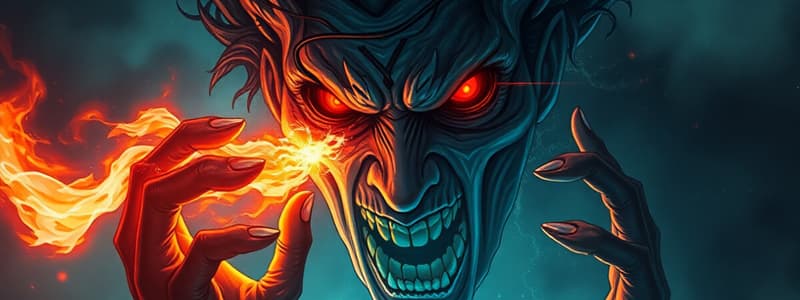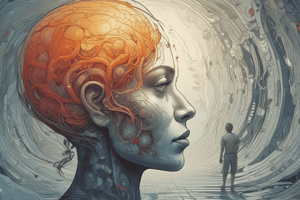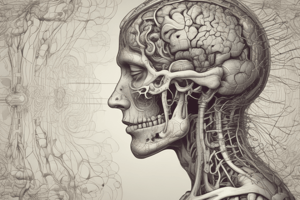Podcast
Questions and Answers
Quelle description correspond le mieux à la phobie spécifique?
Quelle description correspond le mieux à la phobie spécifique?
- Peur persistante d'objets ou de situations définies. (correct)
- Peur réactive face à un stress aigu.
- Peur aiguë liée à des souvenirs traumatiques.
- Peur limitée à un environnement naturel.
Quel aspect ne fait pas partie des symptômes de l'état de stress post-traumatique (ESPT)?
Quel aspect ne fait pas partie des symptômes de l'état de stress post-traumatique (ESPT)?
- Engourdissement émotionnel.
- Peur d'un stimulus phobogène. (correct)
- Symptômes d'intrusion.
- Hypervigilance.
Quelle caractéristique est commune aux schémas 'pré-trauma' peu enclins au ESPT?
Quelle caractéristique est commune aux schémas 'pré-trauma' peu enclins au ESPT?
- Vision positive validée. (correct)
- Vision inflexible du monde.
- Vision illusoire du soi.
- Vision négative de soi.
Comment peut-on qualifier un stress chronique?
Comment peut-on qualifier un stress chronique?
Quelle affirmation est incorrecte concernant les symptômes liés à l'ESPT?
Quelle affirmation est incorrecte concernant les symptômes liés à l'ESPT?
Quelle est la principale différence entre l'anxiété et la peur ?
Quelle est la principale différence entre l'anxiété et la peur ?
Quels sont les symptômes typiques d'une attaque de panique ?
Quels sont les symptômes typiques d'une attaque de panique ?
Comment l'anxiété peut-elle être considérée dans son aspect pathologique ?
Comment l'anxiété peut-elle être considérée dans son aspect pathologique ?
Quel rôle joue l'hypothalamus dans la gestion de l'anxiété ?
Quel rôle joue l'hypothalamus dans la gestion de l'anxiété ?
À quoi l’anxiété est-elle principalement liée ?
À quoi l’anxiété est-elle principalement liée ?
Quel est le rôle principal de la peur dans le cadre d'une menace?
Quel est le rôle principal de la peur dans le cadre d'une menace?
Qu'est-ce qui distingue la peur des situations cliniques des peurs courantes?
Qu'est-ce qui distingue la peur des situations cliniques des peurs courantes?
Quel système est principalement impliqué dans la réaction de peur?
Quel système est principalement impliqué dans la réaction de peur?
Les peurs innées et spécifiques des espèces se distinguent par:
Les peurs innées et spécifiques des espèces se distinguent par:
Quel stimulus déclenche la réponse de peur dans le cerveau?
Quel stimulus déclenche la réponse de peur dans le cerveau?
Flashcards
Définition de la peur
Définition de la peur
La peur est une réaction psychophysiologique à la perception d'un danger, qui suscite une réponse de protection/défense de l'organisme.
Système Nerveux impliqué dans la peur
Système Nerveux impliqué dans la peur
Le système nerveux autonome-sympathique est principalement impliqué dans la réaction de peur, avec les réponses "Fight vs Flight vs Freeze".
Peurs innées vs acquises
Peurs innées vs acquises
Certaines peurs sont innées et spécifiques aux espèces, tandis que d'autres peuvent s'apprendre.
Peurs irrationnelles
Peurs irrationnelles
Signup and view all the flashcards
Objets de la peur
Objets de la peur
Signup and view all the flashcards
Phobie spécifique
Phobie spécifique
Signup and view all the flashcards
État de stress post-traumatique (ESPT)
État de stress post-traumatique (ESPT)
Signup and view all the flashcards
Symptômes d'intrusion ESPT
Symptômes d'intrusion ESPT
Signup and view all the flashcards
Facteurs de stress
Facteurs de stress
Signup and view all the flashcards
Schémas pré-trauma
Schémas pré-trauma
Signup and view all the flashcards
L'axe hypothalamo-hypophysaire
L'axe hypothalamo-hypophysaire
Signup and view all the flashcards
Symptômes d'attaque de panique
Symptômes d'attaque de panique
Signup and view all the flashcards
Anxiété
Anxiété
Signup and view all the flashcards
Peur
Peur
Signup and view all the flashcards
Troubles anxieux
Troubles anxieux
Signup and view all the flashcards
Study Notes
Introduction
- The presentation covers various emotional states, including fear, stress, anxiety, and anguish.
- The content is part of a course on "Motivation and Emotion" (PSY1045).
- The presenter is Yi Shen.
Fear
- Fear is a cascade of psychophysiological events triggered by perceived danger.
- It elicits a protective/defensive response in the organism.
- Fear is typically an adaptive response to threatening situations.
- Fear primarily involves the autonomic-sympathetic nervous system.
- Some fears are innate and specific to animal species; others are learned.
- Many common fears in the population are irrational (e.g., fear of spiders, snakes).
Specific Phobias
- Specific phobias involve marked and persistent fear of specific objects or situations.
- Exposure to phobic stimuli invariably causes an immediate anxious response.
- Phobias can be categorized by the type of stimulus (animal, environmental, blood-injection-injury, situational).
Post-Traumatic Stress Disorder (PTSD)
- PTSD develops following exposure to extreme traumatic stressors.
- The link to the event can be direct experience, witnessing, or learning about it.
- PTSD can manifest as acute, chronic, or delayed onset.
- Symptoms include intrusion/re-experiencing, avoidance, and negative alterations in cognition and mood.
Pre-Trauma Schemas
- Five types of schemas can pre-dispose someone to PTSD:
- Balanced vision (low risk)
- Inflexible positive vision (high risk, esp with sudden changes)
- Inflexible positive illusionary vision (high risk esp with delayed responses)
- Negative world vision, positive self-view (some risk)
- Negative world vision, negative self-view (higher risk)
Stress
- Stress is a collection of physical and emotional responses when an individual experiences unusual pressures, demands, or constraints.
- Stressors include everyday events/situations that may be temporary or chronic.
- Key elements of stress response (CINÉ): low control, unpredictability, novelty, threat to the ego.
Stress Management
- Stress management strategies involve finding solutions to managing stress.
Anxiety
- Anxiety is a subjective feeling of apprehension stemming from anticipating danger, either internal or external.
- It contrasts with fear, which is grounded in a perceived, real danger.
- An unresolved fear can lead to long-term anxiety.
- Anxiety disorders include generalized anxiety disorder, phobias, social phobia, separation anxiety disorder, selective mutism, panic, and agoraphobia.
Maintaining Anxiety
- Anxiety can escalate along with a tendency to avoid the feared stimulus or situation.
Mechanisms to treat Anxiety
- Treatment methods commonly involve cognitive-behavioral approaches, including exposure, relaxation techniques, and cognitive restructuring.
Agoraphobia
- Agoraphobia is characterized by anxiety about places and situations where escape might be difficult or help unavailable in case of a panic attack.
- Symptoms of agoraphobia often resemble panic attacks.
Worry (Inquiétude)
- Worry entails the cognitive process of anticipating and appraising potential issues, and potentially creating or evaluating plans.
- It can also be considered a coping mechanism, a way of avoiding negative emotions or outcomes.
Generalized Anxiety Disorder (GAD)
- GAD involves excessive worries (with apprehensive expectation) that persist over at least six months.
- Concerns typically encompass various life aspects.
- Common symptoms include anxiety and worry that is difficult to control.
Symptoms of Generalized Anxiety Disorder
- Common symptoms of GAD include excessive worry, difficulty controlling worry, muscle tension, irritability, fatigue, sleep disturbances, and more.
Obsessive-Compulsive Disorder (OCD)
- Symptoms of OCD include intrusive, unwanted thoughts (obsessions) and repetitive behaviors or mental acts (compulsions) aimed at reducing anxiety stemming from those obsessions.
Fear vs Anxiety
- Fear is a response to a perceived immediate threat.
- Anxiety is a response to a perceived future threat.
Models of Anxiety (Clark's Cognitive Model)
- Clark's model highlights the interplay between physical sensations, their interpretation (often catastrophic), and the resulting anxiety.
- A cycle of misinterpretations, physical responses, and escalating worry characterizes anxiety.
Panic Attacks
- Panic attacks manifest as sudden surges of intense fear or discomfort.
- Symptoms can include palpitations, sweating, trembling, shortness of breath, chest pain, dizziness, or feelings of choking.
- Attacks can be unexpected (unprovoked) or triggered by situations.
Trauma types
- Some examples of trauma types are:
- Trauma caused by the absence of an object.
- Fear linked to castration.
- Fears linked to separation or abandonment.
Treatment strategies
- Techniques for treatment of anxiety commonly include analytic techniques and psychodynamic approaches.
Mentalizing
- Mentalizing encompasses the capacity to understand and interpret thoughts and feelings in oneself and others (i.e., mindreading).
Studying That Suits You
Use AI to generate personalized quizzes and flashcards to suit your learning preferences.




